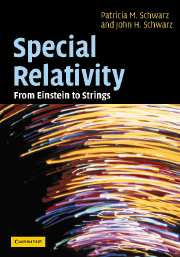Book contents
- Frontmatter
- Contents
- Preface
- Part I Fundamentals
- 1 From Pythagoras to spacetime geometry
- 2 Light surprises everyone
- 3 Elements of spacetime geometry
- 4 Mechanics in spacetime
- 5 Spacetime physics of fields
- 6 Causality and relativity
- Part II Advanced Topics
- Appendix 1 Where do equations of motion come from?
- Appendix 2 Basic group theory
- Appendix 3 Lie groups and Lie algebras
- Appendix 4 The structure of super Lie algebras
- References
- Index
4 - Mechanics in spacetime
Published online by Cambridge University Press: 06 July 2010
- Frontmatter
- Contents
- Preface
- Part I Fundamentals
- 1 From Pythagoras to spacetime geometry
- 2 Light surprises everyone
- 3 Elements of spacetime geometry
- 4 Mechanics in spacetime
- 5 Spacetime physics of fields
- 6 Causality and relativity
- Part II Advanced Topics
- Appendix 1 Where do equations of motion come from?
- Appendix 2 Basic group theory
- Appendix 3 Lie groups and Lie algebras
- Appendix 4 The structure of super Lie algebras
- References
- Index
Summary
Hands-on exercise: review of Galilean relativity
To complete this exercise you will need the following:
A large flat level smooth surface, like the top of a table or desk, and some smooth round glass marbles or a pool table and some billiard balls.
The purpose of this exercise is to compare observations in the two coordinate frames most relevant to particle physics – the rest frame of a particle in a collision, and the center of momentum frame of two colliding particles. In the first case a moving marble or billiard ball moving with speed v strikes another one that is initially at rest. Repeat this a few times. Devise a method to determine the final speeds and directions of the two marbles or balls as accurately as you can from the point of view of an observer at rest. For the second case, the center of momentum (CM) frame, there are two possible approaches. You can try to put the two balls or marbles into simultaneous motion on a collision course with equal speeds. The alternative is only to have one ball in motion, as in the first part of the exercise, but to observe the collision in a frame that is moving with speed v/2 so that the two marbles or balls appear to have equal and opposite velocities. Try to make repeated observations for each of these two alternatives.
- Type
- Chapter
- Information
- Special RelativityFrom Einstein to Strings, pp. 95 - 126Publisher: Cambridge University PressPrint publication year: 2004

